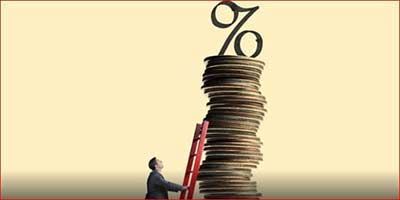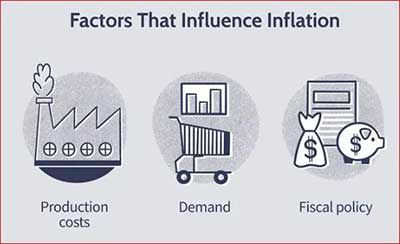Relevance: Indian Economy and issues relating to planning, mobilization, of resources, growth, development, and employment.
Key Phrases: Inflation rate, Reserve Bank of India, domestic consumers, domestic consumers, Consumer Price Index, purchasing power, corporate profitability.
Why in News?
- Recent official data revealed that retail inflation had grown by 7.8% in April. In other words, the general price level Indian consumers faced was almost 8% higher than it was in April last year.
- This is not only the highest rate in the last eight years but also almost twice the inflation rate targeted by the Reserve Bank of India.
Background:
- The war in Ukraine and the associated inflation via higher prices of crude oil are significant contributors, April’s high inflation data is neither unexpected nor a one-off spike.
- Retail inflation has been high since October 2019 and has, in fact, touched the 4% mark just once since then. In all other months, it has not only been higher than 4% but regularly breached the 6% mark.
- April’s inflation is the seventh straight month when the inflation rate has gone up. Further, inflation in India has been above 6% since the start of 2022 (before Russia’s invasion of Ukraine happened in February) and the eventual pass-through of the higher crude oil prices to domestic consumers (which started happening in late March after elections to five Assemblies were completed).

What is Driving Inflation?
- Headline inflation is calculated using the Consumer Price
Index. This index had different categories with varying weights. There
are three main categories:
- Food Items: Which account for 46% of the index.
- Fuel & Light: With a weight of 7%.
- Core: All other items, which make up the remaining 47%.
- Given the different weights, it is important to understand that a 10% increase in food items will raise the overall inflation far more than a 10% increase in fuel prices.
- And in 2020-21, when the pandemic hit the economy, food prices rose by an even larger factor (7.3%) and even core inflation rose by 5.5%.
- But until then, fuel price inflation was still low at 1.3% in 2019-20 and 2.7% in 2020-21.
- In 2021-22, the year when the global economy started recovering sharply, even though food price inflation moderated to 4%, fuel prices rose by 11.3% and core inflation went up to 6%.
- In the current financial year, it is estimated that all three components will experience an inflation rate of 6% or more.
Key Concepts
- Headline Inflation: It is a measure of the total inflation within an economy, including commodities such as food and energy prices (e.g., oil and gas), which tend to be much more volatile and prone to inflationary spikes.
- Core Inflation: It is the change in the costs of goods and services but does not include those from the food and energy sectors.
- Demand-Pull Inflation: Demand-pull inflation is the most common cause of rising prices. It occurs when consumer demand for goods and services increases so much that it outstrips supply.
- Cost-Push Inflation: When a country lowers its currency’s exchange rates, it creates cost-push inflation in imports. That makes foreign goods more expensive compared to locally produced goods.
Good Impacts of Inflation:
- Helps the government meet debt obligations:
- In the short term, the government, which is the single largest borrower in the economy, benefits from high inflation.
- Inflation also allows the government to meet its fiscal deficit targets.
- Mixed results for corporate profitability:
- In the short term, corporates, especially the large and dominant ones, could enjoy higher profitability because they might be in a position to pass on the prices to consumers.
- Higher Profits:
- Inflation, usually, benefits the producers of products. They experience better profits since they can sell their products at higher prices.
- Increase in Production:
- Once the producers receive the right investment, they create more goods and services. Hence, inflation leads to an increase in the production of products/services.
Bad Impacts of Inflation:
- Reduces people’s purchasing power:
- Higher inflation restricts people’s ability to purchase things. The poor are the worst affected because they have a little buffer to sustain through long periods of high inflation.
- Reduces Overall Demand:
- The eventual fallout of reduced purchasing power is that consumers demand fewer goods and services. Typically, non-essential demands such as a vacation get curtailed while households focus on the essentials.
- Worsens the exchange rate:
- High inflation means the rupee is losing its power and, if the RBI doesn’t raise interest rates fast enough, investors will increasingly stay away because of reduced returns.
- Leads to expectations of higher inflation:
- Persistently high inflation changes the psychology of people. People expect future prices to be higher and demand higher wages. But this, in turn, creates its own spiral of inflation as companies try to price goods and services even higher.
Conclusion:
- Inflation can impose a real cost on society in terms of the efficiency with which the exchange mechanism works, by distorting the incentives to save, invest, and work, and by providing incorrect signals that needlessly alter production and work effort.
- In the short term, inflation creates winners and losers, but in the eventual analysis, everyone suffers if it stays persistently high.
- Hence, policymakers should be concerned with the ongoing rate of inflation and take immediate steps to control it.
Sources: Indian Express
Mains Question:
Q. What are the factors that have kept inflation high since October 2019? How does inflation impact consumers and the economy? (250 words).









